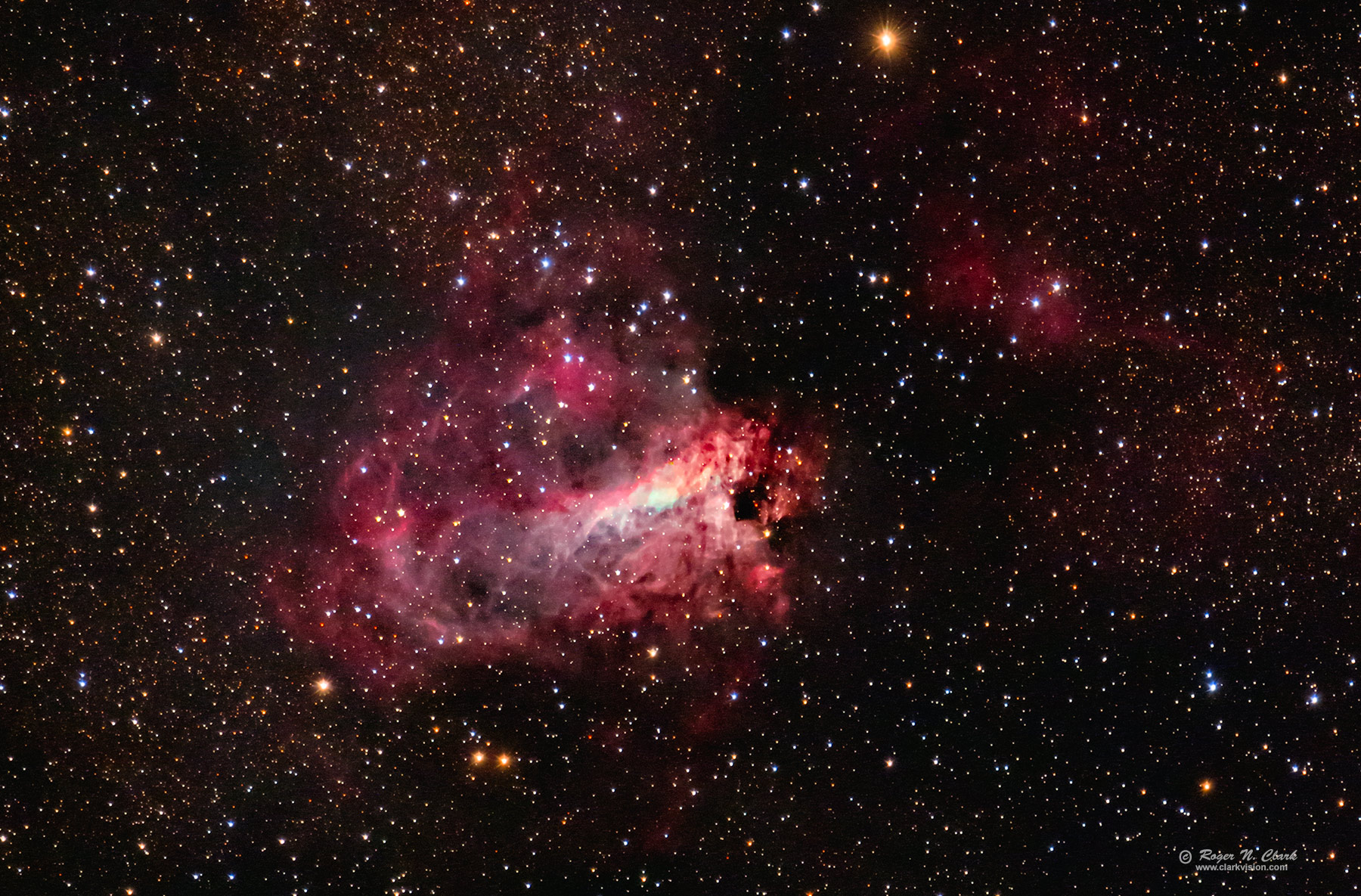| Home | Galleries | Articles | Reviews | Best Gear | New | About | Contact | Gallery Index | Previous |
Next |

| Home | Galleries | Articles | Reviews | Best Gear | New | About | Contact | Gallery Index | Previous |
Next |

The emission nebula M17 is a beautiful nebula in the constellation Sagittarius, about 5000 to 6000 light years distant. M17 is a beautiful view in amateur telescopes from dark sites, showing a lot in intricate detail. M17 is one of the brightest and most massive star-forming regions in the Milky Way. Many of the stars seen in and near M17 are hot young O and B-type stars, while most of the stars seen in the region are old cooler yellow to red stars, stars cooler than our sun.
This is a natural color image. The high dynamic range of astrophotos must be stretched to bring out the range of details the camera recorded. But the typical image stretch process loses color for brighter subjects (e.g. stars and the brighter parts of deep sky objects become whiter as they are made brighter). This image uses a new Rawtherapee raw conversion method, and a new algorithm, rnc-color-stretch that does not lose color during the stretch. How do we know the colors are reasonable? The star colors can be checked against stellar photometry. Red stars have B-V > 2, orange stars have B-V of 1 to about 2. The blue-white stars have B-V in the range of 0 to -0.5. The colors closely follow the color sequence in Table 1 at Color of Stars. Solar-type stars have a B-V of 0.63 and appear close to white (daylight white balance).
The color in M17 illustrates several compositional trends. Hydrogen emission nebulae are pink/magenta, and that color is common in the brighter parts of the nebula. The brightest part of the nebula is greenish (teal) from oxygen emission at 500.7 nm. Toward the edges of the nebula, the magenta color turns redder. The pink/magenta is a combination of H-alpha emission (red), H-beta (blue-green), and H-gamma (blue). Toward the edges of the nebula where the color is redder, interstellar dust absorbs the H-gamma and H-beta more than the H-alpha, turning the pink emission red. Throughout the region away from the nebula is interstellar dust, appearing burnt-orange.
Technical. This image was obtained with a stock Canon EOS 90D DSLR Camera and Canon 500 mm f/4 L IS lens (Newer model: Canon EF 500mm f/4L IS II USM Lens). Total exposure time was 15 minutes (ONLY ten 90-second exposures) at ISO 1600. This is a natural color image. Post processing: raw conversion with Photoshop ACR (normally I would use rawtherapee, but the color matrix correction in rawtherapee did not do well with the emission), stacking with deep sky stacker, Stretched with rnc-color-stretch, and final adjustments in photoshop. No darks, no flats, no bias frames (flat field is in the ACR lens profile and corrected during raw conversion). The exposures were tracked on a Losmandy G11 equatorial mount with an autoguider. Mean RMS tracking accuracy was around 0.5 arc-second. The full resolution image is 1.32 arc-second / pixel, and this image is at 2/3 that scale, 1.98 arc-seconds / pixel. The image was made in Colorado at an elevation of about 7600 feet, Bortle 4, sky brightness: red = 20.8, green = 21.1, blue = 21.6 magnitudes / sq. arc-second.
This is a natural color image.
The Exposure Factors, CEF, CEFA are measures of the relative amounts of light received from a subject. It can be used to fairly compare wildly different lens/telescope apertures and exposure times. For this image on the sky:
Modern digital cameras like the Canon 90D include on sensor dark current suppression technology and low fixed pattern noise at ISOs around 800 and higher, making no need for dark frame subtraction. Modern raw converters correct for light fall-off and also correct for hot/dead/stuck pixels. This makes processing low light images easy: simply align and average.
Also see Astrophotography Image Processing Basic Work Flow.
To learn how to obtain stunning images like this, please visit my Extensive Articles on Photography .
Keywords to this image = astrophoto-1 nebula Messier low-light digital_astro canon_90d rnc-color-stretch
Image ID: m17-500mm-09-04-2021-acr-IMG_0993-003-av10-c2-1x-rs2,2-e.67s.jpg
| Home | Galleries | Articles | Reviews | Best Gear | Science | New | About | Contact |
Last updated November 08, 2025